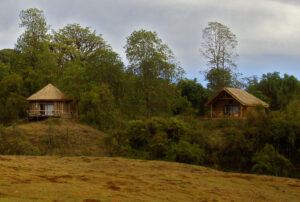overview
Bale Mountain Lodge is an eleven room boutique forest wilderness lodge, deep within the Bale Mountain National Park (BMNP) of south central Ethiopia. Larger groups or families can be accommodated in a three bedroomed, rustic house with its own sitting room. The Lodge started operating in October 2013, and was officially opened on January 18th 2014. The location of the Lodge has been selected to provide an excellent opportunity for guests to experience a pristine wilderness environment that incorporates the largest tract of Afro- Alpine moorland remaining on the African continent, the majority of the plateau being over 3,800m above sea level – with Africa’s highest all weather road snaking over the top – truly the roof of Africa. The Lodge itself is situated in the heart of the Park within the Harenna Forest at a more comfortable 2380m, within the beautiful Katcha clearing looking towards the ridgeline of the plateau. Several shorter walking trails lead from the Lodge which enable guests to see wildlife on foot. Bale Mountain National Park is known as‘One Park- Many’ worlds. From the Gaysay grasslands of the north to the high altitude Sanetti plateau, to the wild forests of the south, the amazing range of habitats support myriad rare and endemic species, many of which are only found in this Park. The main wildlife attraction, and almost an ‘icon’ for Ethiopian wildlife travel is the Ethiopian Wolf. The Sanetti Plateau is home to the largest numbers of the remaining Ethiopian wolves. They are the world’s rarest canid and Africa’s rarest carnivore. Other endemics include the Mountain Nyalla, Menelik’s Bushbuck, Bale Monkey, Bale and Harenna Chameleon and Stark’s Hare. There are several endemic rodent species including the charming Giant Mole Rat, the staple diet of the Wolf. The Park is a birdwatcher’s paradise and has been rated ‘4th best birding site in Africa’ by the African Birding Club. Several teams of research scientists visit the Park throughout the year and are happy to liaise with guests. Since opening Munich University have discovered 22 new species of butterflies and moths, and we are very pleased to have one name after our family. More recently, a viper has been officially ‘discovered’ jointly accredited to Mississippi and Utah universities and named Harenna Bitis. It may not be everyone’s favourite but in a modern world it is great to be living in an area where new creatures are being scientifically ‘discovered’.















